Progress report for FW24-015
Project Information
A “paradox” of irrigation efficiency has developed during the
widespread conversion of irrigation methodology, from flooding of
fields to pipes and sprinklers. The former diverts a greater
volume of water, but much of it is not consumed; unconsumed can
then enter the shallow groundwater and travel to the creek over
the summer months (return flows). Sprinkler methods divert much
less water, but consumption is higher, so less water percolates
through the soil profile and back to the creek. Potential impacts
of this conversion include: reduced late-season return flows,
shallower rooting zones, and reduced productivity, especially
regrowth after the first cutting. All of these have implications
for soil health, streamflow, and farm profitability. The research
question posed is, “Can the hydrologic, soil, and agricultural
benefits of flood irrigation be captured by modifying the
early-season application of a center pivot to deliver a higher
volume of water?”
We expect that modifying the sprinkler technique will increase
late-season return flows, soil moisture at depth, and
productivity (hay produced and regrowth). Maintaining late-season
return flows will provide more water to downstream irrigators and
lessen the likelihood of senior users making water calls on
juniors. Increased soil moisture will stimulate root growth and
microbial activity to enhance soil health and sustainability.
Overall productivity will increase, resulting in greater
profitability. Results from this project will advance sustainable
agriculture by providing a comprehensive suite of monitoring data
(hydrology, soil moisture and infiltration, surface water
quality, agricultural productivity) to share with other producers
and agricultural professionals. Projects results will be
disseminated to the local community and producers through meeting
presentations and a ranch tour (publicized through social media,
press release, and newsletters). A 2-page handout will be
produced for distribution, and results will be conveyed to the
scientific community at a professional water resources meeting
and/or journal article.
Research
Objectives
Objective 1. Demonstrate the feasibility of modified irrigation
technique.
Objective 2. Quantify effects of modified irrigation technique on
the hydrology, soil, and agricultural production and develop
ranch-scale water balance.
Objective 3. Synthesize results for dissemination.
Education
Objectives
Objective 1. Share project results with local producers and
agricultural professionals through presentations at regular
meetings and statewide conventions.
Objective 2. Host ranch tour to share results with local
community, producers, and agricultural professionals.
Objective 3. Disseminate results to academic and professional
communities through conference presentation and/or publication in
a peer-reviewed or professional journal.
| Date | Activities | Team members |
|
April-November 2024 |
Install monitoring equipment and collect baseline data on hydrology, soil moisture, water quality, production. Take "before" photos |
PI (Thomas), TA (Lunzer), and collaborator (Kurth) |
|
November-April 2024-25 |
Compile and analyze baseline data. |
PI (Thomas) and TA (Lunzer) |
|
April – November 2025 |
Begin operating the east side pivots using modified irrigation technique. Continue monitoring as in 2024. Take year 2 photos |
PI (Thomas), TA (Lunzer), and collaborator (Kurth) |
|
November-April, 2025-26 |
Compile and analyze year 1 data; compile lessons learned regarding technique feasibility. Completion of Research Objective 1 Prepare Power Point slides and draft of handout Begin presenting project at local meetings. |
PI (Thomas), TA (Lunzer), and collaborator (Kurth) |
|
April – November 2026 |
Continue operating east side pivots as in 2025 or modify based on information learned. Continue monitoring as in previous year. Develop preliminary data synthesis. Take year 3 photos |
PI (Thomas) and TA (Lunzer) |
|
July 2026 |
Host half-day field tour hosted on the ranch to showcase the innovative approach and summarize the measured benefits of the project. Provide draft handout to participants. Completion of Education Objective 2 |
PI (Thomas) |
|
October – February, 2026-27 |
Complete data compilation and analyses; synthesize data for outreach. Completion of Research Objectives 2 and 3 Finalize outreach materials (Power Point slides and handout) and complete presentations at local and statewide meetings. Present project at Montana AWRA meeting and/or draft manuscript for publication. Completion of Education Objectives 1 and 3 |
PI (Thomas), TA (Lunzer), and collaborator (Kurth) |
|
February – March, 2027 |
Complete final grant report |
PI (Thomas) |
Cooperators
- - Technical Advisor
Research
The project site is Thomas Herefords Ranch in Gold Creek, Montana. The ranch is located near the mouth of Gold Creek, and the project will focus on three pivot-sprinkler-irrigated fields. These three pivots irrigate roughly 260 acres, two on the east side of the creek and one on the west side (see attached project map). Grass is grown on one of these fields while the other two fields are split between grass and alfalfa/orchard grass mix.
The project will occur over three years. In year 1, we will install the monitoring equipment and collect baseline data. In years 2 and 3, we will modify the pivots on the east side of the creek (modified irrigation technique) to apply as much water as possible early in the season by increasing the overall amount of time the pivot is run, not increasing the flow rate of the system. The west side pivot will operate as normal (control). Comparison data will include previous years’ hay production, baseline data from year 1, and the west pivot, which will control for inter-annual variability. To ensure that the timing and volume of water diverted will not negatively impact fisheries, Bruce will consult with staff from Montana Department of Fish, Wildlife & Parks (1 pre-irrigation meeting per year; follow up communications as needed).
We have already secured financial, equipment, and/or staff time support from several state entities (Natural Resource Damage Program, Department of Natural Resources and Conservation, DNRC, and Department of Environmental Quality, DEQ), which will partially cover the costs of project monitoring. The focus of this grant request is to cover the remaining costs for equipment, supplies, and electricity costs.
Although Objectives 1 and 2 overlap, they measure different aspects of the modified irrigation technique (feasibility vs. effects) so can be assessed independently. Objective 3 relies on the results of 1 and 2, but can be completed regardless of outcomes; i.e., if electricity is expensive or return flows are undetectable, results still provide valuable knowledge.
Objective 1. Demonstrate the feasibility of modified irrigation technique.
Producers may anticipate challenges or barriers to using the modified irrigation technique, so it is important to demonstrate feasibility and address potential questions. Specifically, we will assess:
- Electricity costs. Higher costs incurred from increased pumping will be tracked and compared with normal operations.
- Mud on wheel tracks. Muddy conditions may bog down the pivot wheels; this will be mitigated by installing directional nozzles.
- Shifts in species composition. Producers may worry about inadvertently creating wetlands on their fields. Species composition will be monitored using vegetation plots (1x1 meter, 3 times per season) or comparable approach. Water application rate and volume will be adapted if compositional shifts occur.
- Changes to production. Increasing the water volume may retard plant growth, and production may be lower next to the wheel tracks depending on the functioning of the directional nozzles. We will visually monitor plant growth and adapt water application as necessary; changes to production will be monitored as part of Objective 2.
All photos (before, after, during), lessons learned, costs, and adaptations from this experiment will be recorded and compiled as part of the demonstration of feasibility.
Objective 2. Quantify effects of modified irrigation technique on the hydrology, soil, and agricultural production and develop ranch-scale water balance.
We will use a robust monitoring network to quantify the effects of the modified irrigation technique on hydrology, soils, and agricultural production. Specifically, we will measure:
- Volume of water pumped from creek and applied using the pivots.
- Streamflow using three stream gages. One gage is already installed near the center of the project area (incidentally, this gage is located at the site of a retired stream gage that operated during the 1960s when the entire basin was flood irrigated, so it will provide interesting comparison data). Two others will be added on Bruce’s property: one where the creek enters and one where it leaves.
- Soil moisture using six multi-depth probes
- Surface water quality in the creek at two locations (above and below) monthly throughout the season. Runoff (erosion and/or fertilizer) will be evaluated by analyzing samples for forms of nitrogen, phosphorus, and suspended solids, as recommended by DEQ.
- Evapotranspiration and precipitation using a Mesonet station (collaboration with the Montana Climate Office).
- Soil infiltration using a soil infiltration ring. Tests will be performed monthly; before, during and after sections of each field are irrigated.
- Shallow groundwater near the creek using hand-dug wells with twelve piezometers (groundwater level monitoring wells).
Deep groundwater using five, 4” monitoring wells to be drilled.We were unable to procure a drilling contractor, so, instead, we built and installed five lysimeters to measure vadose zone water flux, and we hand-augered 18 additional piezometers across the site to monitor groundwater levels and fluxes.
Streamflow, groundwater, and other hydrologic monitoring data will allow John to use a MODFLOW-based numeric groundwater model to develop a ranch-scale water balance. The water balance will quantify the amount of water being added to the local aquifer and contributing to return flows, allowing us to directly quantify how the modified irrigation system impacts local hydrology.
Effects on crop production and soils will also be assessed. Quantity of hay produced will be compared with previous years, and regrowth will be estimated using established DNRC methods for consumptive water use. Root depth (as a proxy for microbial activity and soil health) will be estimated using soil cores (6 per pivot; sampled consistently in late season) or other comparable method.
Collectively, documenting changes in crop production, soil moisture, and rooting depth will quantify effects of the modified irrigation technique on agricultural production and soil health, while hydrologic monitoring will quantify changes to groundwater and return flows. Estimating all these aspects and any impacts to surface water quality is critical to providing other producers enough information to feel comfortable adopting this approach in their operation.
Objective 3. Synthesize results for dissemination.
We will synthesize the data and observations from Objectives 1 and 2 to develop salient and understandable summaries. Results will be integrated into compelling visuals (e.g., figures, diagrams, and/or infographics) that are accessible to producers and demonstrate the costs and benefits of the modified irrigation technique.
We successfully installed all of the planned monitoring equipment and began collecting baseline data (see attached project design map. The variables collected in 2024 include:
- Stream flows - Gages installed at 3 locations along Gold Creek (2 seasonal and 1 real-time gage). Data are updated on DNRC's Stream and Gage Explorer web application (also see attached screenshot).
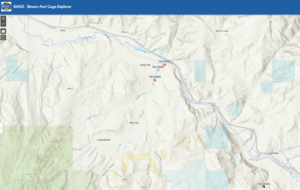

- Groundwater - 30 shallow groundwater wells were installed. Well depths monitored with data loggers.


- Irrigation use and ditch seepage - ditch flows were measured at 9 locations monthly during irrigation season to calculate use and seepage.
- Surface water quality - Surface water in the creek was sampled at two different locations (next to the seasonal stream gages; upstream end and downstream end of property) on 9 occasions throughout the season: once a month in April, July, August, September, and October, and twice a month in May and June. Samples were analyzed for total nitrogen, total phosphorus, and total suspended solids, and water pH and electrical conductivity were recorded.
- Groundwater quality - groundwater was sampled at 3 different wells on 8 occasions (same as surface water without April). Samples were analyzed for total nitrogen and total phosphorus, and water pH and electrical conductivity were recorded.


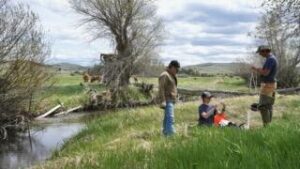
- Agricultural productivity - will be estimated using Bruce's records.
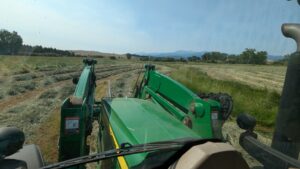
- Evapotranspiration - measured with a LiCOR 710 sensor.
- Vegetation - community composition and rooting depth were not assessed this year because of time constraints, but both will be monitored in 2025 and 2026.
- Weather data - the weather station records and transmits a suite of weather variables, including precipitation, temperature, soil moisture, wind speed/direction, and solar radiation.
- Soil characteristics and properties - a suite of variables, including vadose zone flux using passive flux lysimeters, soil moisture, soil water potential, and infiltration.




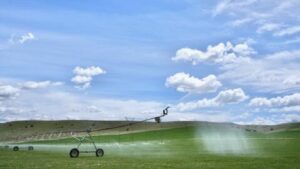
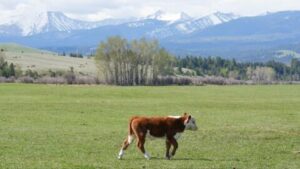
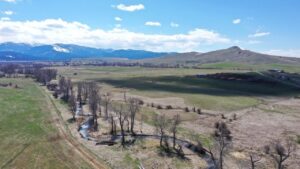
Research outcomes
Detailed, data-supported recommendations for agricultural production and future research are anticipated after years 2 and 3 of the project; however, we learned valuable information during year 1:
- The suite of variables being monitored in this project will provide a detailed understanding of irrigation, evapotranspiration, and unsaturated flow at the ranch-level scale. The 2024 measurements revealed how crop type, soil type and application rate have profound impacts on soil moisture conditions. This improved understanding will aid the project in the coming year as we initiate the modified irrigation practice, and it will also provide valuable information for how current practices can be optimized to promote soil moisture, especially during times of drought.
- Outreach during the 2024 season provided valuable insights into potential challenges of the practice. Specifically, other agricultural producers raised technical questions about pivot operation and potential pitfalls, which will be valuable as we enter year 2.
Education and Outreach
Participation summary:
We believe it is important to share the project results with other producers and agricultural professionals, regardless of the outcomes, because they demonstrate Bruce’s willingness to innovate and will offer insights into local water management strategies. We look forward to discussing producer questions and ideas to further enhance the sustainability of water and soil resources. Other producers may be inspired by this research to pursue their own innovative water management strategies and collaborations.
Objective 1. Share project results with local producers and agricultural professionals through presentations at regular meetings and statewide conventions.
Bruce will share project results with local producers and agricultural professionals by presenting at no less than three regular meetings of local stakeholders, such local conservation district and watershed group board meetings. He will also present results at one or more statewide conventions, such as the Montana Association of Conservation Districts, Montana Stockgrowers Association, Montana Soil Health Symposium and/or the Montana Watershed Coordination Council. He may also present at DNRC-sponsored trainings, such as the annual Water Commissioner Training and/or periodic water measurement training.
We will develop outreach tools to accompany all outreach presentations: 1) Presentation slides using Microsoft Power Point, and 2) Professional handout. The slideshow will include background, research questions, methods, results, and discussion, and it will emphasize visuals, like photos and figures. The professional handout will contain similar information in a two-page format. A professional designer will be contracted to make it visually-pleasing and easy to understand. Both tools will include a summary of research limitations or caveats, like water rights and site-specific geology/soils. The handout will be written in accessible language that does not require background information or knowledge to understand it, and it will be distributed at meetings and events throughout Montana and on the Thomas Herefords website.
Objective 2. Host ranch tour to share results with local community, producers, and agricultural professionals.
We will host a half-day ranch tour during the summer of year 3 (2026) to demonstrate the study results in an interactive setting. The target audience will be producers, agricultural professionals, agency water managers, scientists, and the public. We will partner with the Montana DNRC Rangeland Resources Program, which can provide financial and logistical support, as well as outreach through their newsletter and social media accounts (see Barta letter of support). Other outreach will be conducted using a press release, partner group newsletters, and the DNRC website/social media. The handout produced in Objective 1 will be distributed at the tour in a draft format (year 3 data collection will be incomplete at that time).
Bruce has hosted numerous tours and events in the past and is excited to do so again as part of this project. Participants will have the opportunity to learn first-hand how the project was initiated and monitored, and there will be time set aside for questions and discussion.
Objective 3. Disseminate results to academic and professional communities through conference presentation and/or publication in a peer-reviewed or professional journal.
We think it is important for professional hydrologists and agricultural researchers to learn about the project results. Regardless of the outcome, to our knowledge, this concept has not been tested, monitored, and documented, so we want to ensure that professionals throughout the western U.S. have an opportunity to learn about it. To disseminate the results more broadly, we will give a research presentation at annual meeting of the Montana Chapter of the American Water Resources Association, which is attended by hydrologists and water managers throughout the state. We may also prepare a manuscript for publication in either a peer-reviewed or professional agriculture journal.
Education and outreach results to date are limited because we have only completed one of the three study years, and the majority of the outreach will be done in year 3. However, we felt it was important to conduct some local outreach about the project because many people and project partners are curious and want to learn more about it.
- Project tour for partners and Montana DNRC staff - June 24, 2024. Approximately 22 people participated from DNRC and other state agencies, as well as representatives from several conservation groups. Photos and handouts are attached.
- Project tour for partners in conjunction with annual BBQ at the ranch. Approximately 18 people participated. (SARE survey data collected.)
- Oral presentation at Montana Chapter of the American Water Resources Association in October, 2024. Project Technical Advisor, John Lunzer, gave a presentation about the passive flux lysimeters he built to measure vadose zone water flux. Approximately 25 people watched the presentation.
- Presentation to at the Deer Lodge Valley Conservation District's Annual Livestock Seminar (January 11, 2025). Presentation used a draft of a short film that is currently in development. The film is broadly about the interactions between irrigation and hydrology in Montana, but it will capitalize on the Gold Creek basin and this project as a case study. Fifty-three people participated, most of which were producers. (SARE survey data collected).
A project handout and supporting handouts were distributed at project tours and at the Livestock Seminar.




Note that survey response rate was less than the number of participants. We will try to get more responses at future events.
Education and Outreach Outcomes
We planned to focus on outreach and educational materials, events, and presentations during years 2 and 3 of the project; however, we have learned that early outreach is incredibly useful to project success.
- Handouts (see attached Project handout and Supporting handouts from field tour) - The handouts were a valuable opportunity to draft text and figures that are important to conveying the project, and they will be used as a foundation for the development of future materials. They are also helpful in explaining the project to others because they are easy to share via email or hard copies.
- Tours - We conducted two project tours for project partners and other interested people. Both were valuable opportunities to test different logistics and approaches. For example, the first tour met by the bridge for the project introduction, and then the group walked or drove to one of the lysimeters. This worked well, but conditions for the introduction were hot and the information was fairly abstract (only visual tools were the handouts). For the second tour, we met up at the "new" barn, where people could sit in the shade and watch a video clip of the project, and then we walked a short distance to a different lysimeter site. We would probably use the approach from the second tour for future events.
- Presentations - We presented the project at two different events this year: John gave a methods presentation focused on the lysimeters at the Montana Chapter of the American Water Resources Association annual meeting in October, and then the project leads presented at the Deer Lodge Valley Conservation District's Annual Livestock Seminar in January. The audiences for each presentation were quite different: scientists and hydrologists at the AWRA presentation and ranchers/producers at the Livestock Seminar. Although the distinct audiences were not intended by design, it was incredibly valuable to do outreach to both audiences because it increased project awareness and elicited valuable questions.
Water storage